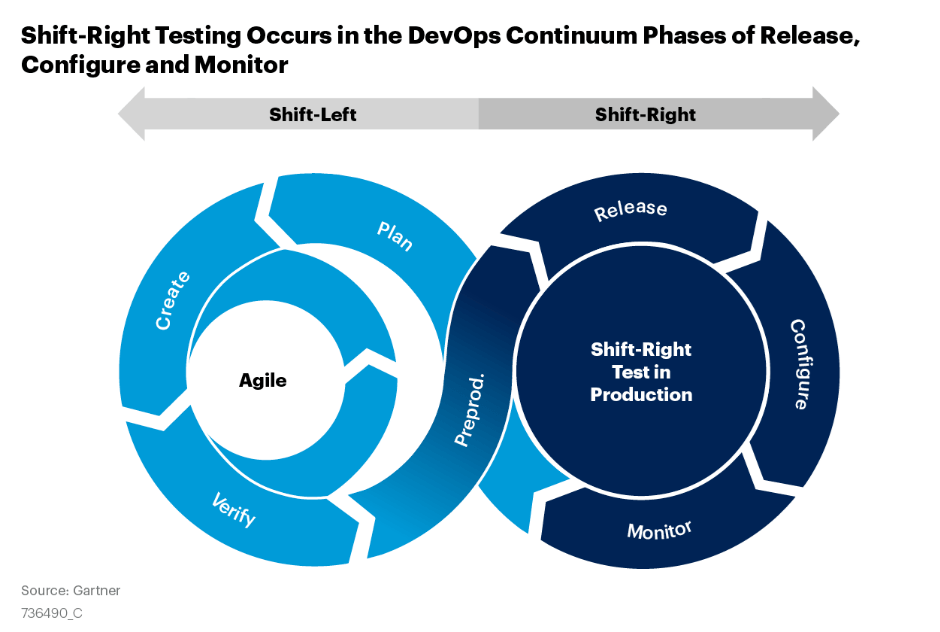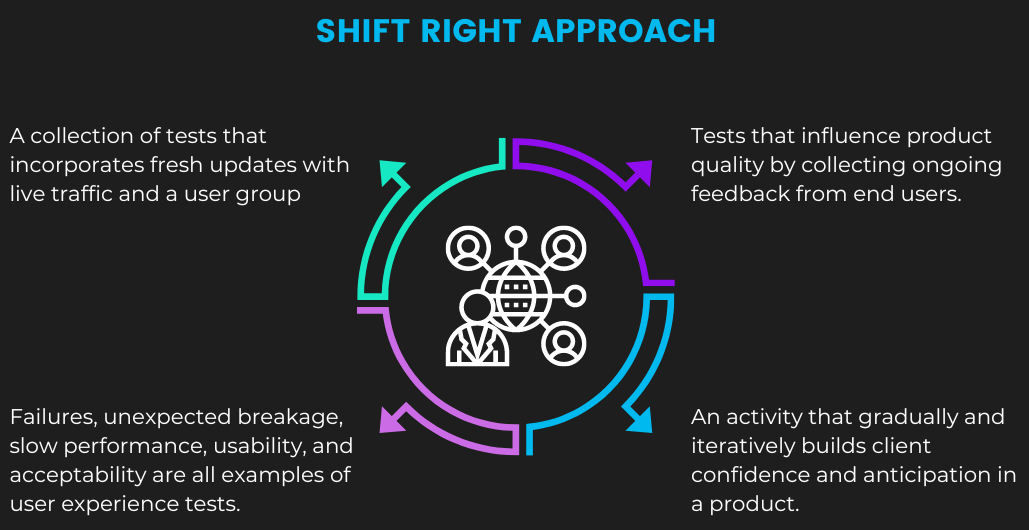Shift right testing approach in production allows a software development (Dev) and IT operations (Ops) team to plan for potential issues. It can also be used to analyze the user’s experience. However, what is critical is to identify testing in production as not something that simply implies releasing untested code in the hope that it will function properly or waiting for defects and bugs to be discovered after it has moved to the customer end.

Shift Right Testing Approach
It is difficult to capture all flaws during the development lifecycle or to simulate a live, real-world situation. As a result, development and quality assurance teams devote significant time and resources on white-box and black-box testing, exploratory testing, and automation testing.
They also contemplate other settings for validating user flows, such as Dev, QA, and User Acceptance Testing (UAT). Dev and QA teams employ mock test data to uncover problems with all potential scenarios, corner situations, and out-of-the-box techniques, but they cannot always capture the end user’s intents. Partially testing code can be problematic because it does not guarantee that the code will work correctly in production. Furthermore, it is critical not to wait for problems to occur in the production cycle or for the users to identify.
- Shift right testing is a collection of tests that incorporates fresh updates with live traffic and a user group.
- Failures, unexpected breakage, slow performance, usability, and acceptability are all examples of user experience tests.
- Tests that influence product quality by collecting ongoing feedback from end users.
- An activity that gradually and iteratively builds client confidence and anticipation in a product.

Benefits of Shift Right Testing Approach
Bug Bash
Shift right testing Identifies and catches more bugs, including identifying different types of bugs. It also reduces the regression testing time. By incorporating IT teams and other employees perspectives, shift right testing enables a streamlined collaboration across teams of production
A/B Testing
- Reduces bounce rates.
- Supports a boost to the conversion rates.
- Easy to understand results.
- Inexpensive.
- An upward trajectory of sales
Canary Testing
Canary testing in shift right ensures the risk landscape is controlled by releasing the feature to only a small percentage of users. It ensures a boost to quality assurance leading to faster release of new features. This approach in shift right facilitates removal of the feature as soon as a defect or bug is identified, It slows down the application and prevents negative feedback from the user. Shift right shortens the feedback loop, thus supporting a faster feedback time and including new features to the production cycle swiftly.
Outcomes of Shift Right Testing Approach in Production
- The entire scope and diversity of the manufacturing environment.
- The actual customer traffic workload.
- Reduces the dangers of continual delivery.
- Customers are assured that the product is ready for production.
- Engineers can add, delete, or edit highlights based on input.
- Increases programme efficiency.
- Aids in the faster dissemination of items.
- Captures issues before they are noticed by end users.
The manufacturing environment is always evolving. Even if a programme does not change, the infrastructure on which it is based does. Shift right testing approach in production validates the health and quality of a specific production deployment as well as the constantly changing production environment.
Rundown
Shift right testing approach in production is becoming an unavoidable component of the testing process. When millions of individuals visit a single piece of software from thousands of various devices, browsers, browser versions, and operating systems, it is difficult to foresee and correct all errors without true user experience. The number of production releases has increased because over 90% of software organizations have adopted agile approaches. Unfortunately, each production release has the potential to alter how things work in the actual world. As a result, DevOps teams must test all changes in production as soon as feasible to assure the dependability of any programme. It can be damaging to a software company’s reputation if these concerns are not discovered before the clients.
Thus, the shift right testing approach in production is extremely beneficial to DevOps-aligned developers and organizations. It improves user experiences, brand reputation, and money by allowing developers to be better prepared to deal with anomalies.



